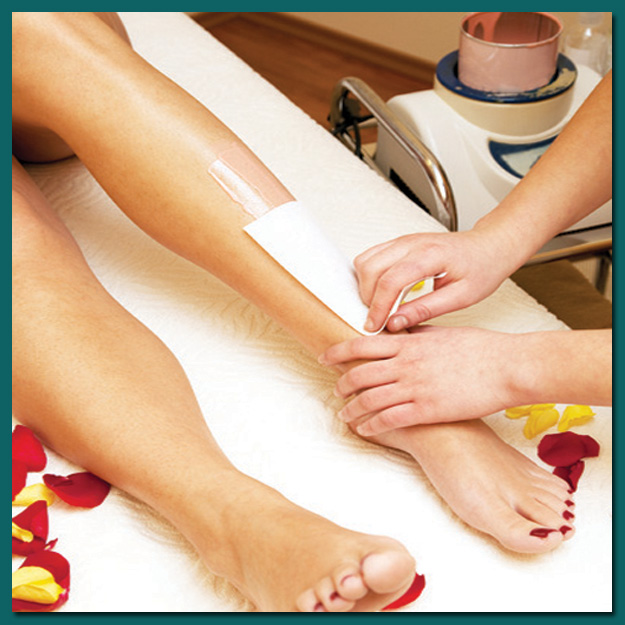When it comes to hair removal, there are a plethora of options. Some are long lasting than others while some may be more painful and have other drawbacks. As salon and spa professionals, it is important to know the ins and outs of each method as hair removal is an extremely common beauty request from women and, before instructing your clients, you need to have a good grasp on hair removal as a whole.
WAXING
Waxing, which generally involves pouring heated wax over the desired treatment area and then quickly ripping that wax off like a Band-Aid in order to remove hair from the root is one of the oldest and most common types of hair removal. Many women like this type of hair removal because it generally lasts about 8 weeks, which is longer than shaving, and does not does not result in the same kind of bristly stubble that shaving does. It is also a very rapid way to remove hair when compared to things like tweezing or electrolysis in that the technician can typically finish the service within a couple of minutes. However, waxing does have its downsides. For one thing, waxing may not be appropriate for people with sensitive skin and may be painful even for those without sensitive skin if the treatment is being applied to sensitive areas like the bikini line. Waxing is also less effective for hair removal that requires a high level of precision such as hair removal around the eyebrows. Finally, for larger areas which require hair removal such as the legs, waxing can be prohibitively expensive even though the results might be more desirable than shaving.
EPILATORS
Electric epilators are newer devices which have arrived on the hair removal scene and, similar to waxing or tweezing, pull hair out at the root using small, moving electric discs to grab the hair and pull it out. Another claim by the manufacturers of epilators and some users is that epilators are capable of grabbing and removing shorter hairs that waxing misses and, for that reason, is more effective and longer lasting than waxing. However, like other methods of hair removal which remove hair at the root, epilation can be painful and can lead to ingrown hairs. Also, like waxing, epilation is not permanent and, sooner or later, the hair will grow back even if it is 8 to 10 weeks after the treatment.

SHAVING
Shaving, while one of the most economical and least painful hair removal methods, also has several downsides. For one thing, hair which is removed by shaving will begin to reappear as stubble in as little as a week. Second, shaving has the distinct possibility of razor burn or small cuts to the skin which could become infected. Shaving can also lead to ingrown hairs like waxing or epilators if specific hairs are cut or bent below the skin horizon. Some also claim that shaving causes hair to grow back thicker and denser than before although this has been disproven and, in fact, simply relates to the fact that shaven hair which begins to reappear can be at different points in the hair growth cycle and appear coarser (or finer) depending on that. Lastly, shaving is generally not appropriate for hair removal which requires detail and precision like that around the eyebrows.
TWEEZING/THREADING
Tweezing and threading can be an effective, if not slightly painful, method of hair removal for smaller treatment areas such as the eyebrow and lip area. The benefit of tweezing/threading is that it can be more precise than other hair removal methods. However, the flip side of that is that it is also not appropriate for larger areas such as the legs or bikini area as trying to remove hair from these areas by tweezing or threading would be prohibitively tedious and time-consuming. Tweezing and threading are also not without their own downsides. Tweezing can cause pitting, scarring and ingrown hairs. Also, like most methods of hair removal, the hair removal is not permanent.

LASER HAIR REMOVAL
Laser hair removal is typically reserved to medical spas or spas that have medically trained staff on hand due to the more complicated nature and process of laser hair removal. While laser hair removal is typically described as semi-permanent to permanent due to the fact that, with one or more treatments the hair in the area which was treated will not grow back. Laser hair removal works by using light, which is later converted into heat, to damage the follicle so that hair is prevented from forming in the future. While laser hair removal is very effective, there are also several downsides. For one thing, depending on the area which is being treated, laser hair removal can cost several hundred to several thousands of dollars per session which means that it is out of reach for many people. Second of all, due to the permanent nature of laser hair removal, if someone who has had laser hair removal later decides that they do not like the outcome of the procedure, there is no way to make the hair grow again.

ELECTROLYSIS
Electrolysis is another hair removal method which, although it can be performed by ordinary spa or salon staff, is generally quite expensive. Electrolysis uses a needle with a small electrical current to destroy hair follicles and, for this reason, is another semi-permanent to permanent method for hair removal. Electrolysis costs between $50 to $100 for a 20 to 30 minute session and, due to the slower nature of electrolysis, might only be appropriate for smaller areas like the eyebrow or lip area. Electrolysis can result in scarring or pitting and, once the results are achieved, may be irreversible. Therefore, anyone who is considering electrolysis should be sure that they are committed to permanent hair removal.
CONCLUSION
There are numerous ways to remove hair and, although they all have their upsides and downsides, some may be more or less appropriate for your clients depending on their budget, skin type and desired treatment area. Therefore, you should assess each case with all of the information at your disposal in order to give your clients the best possible recommendation for their desires.